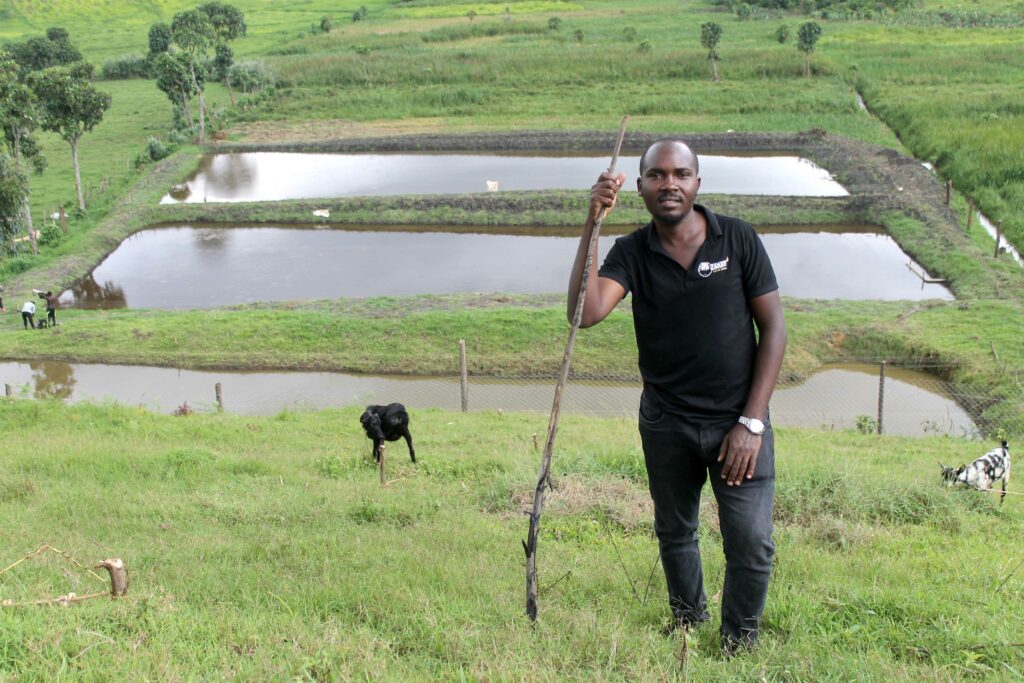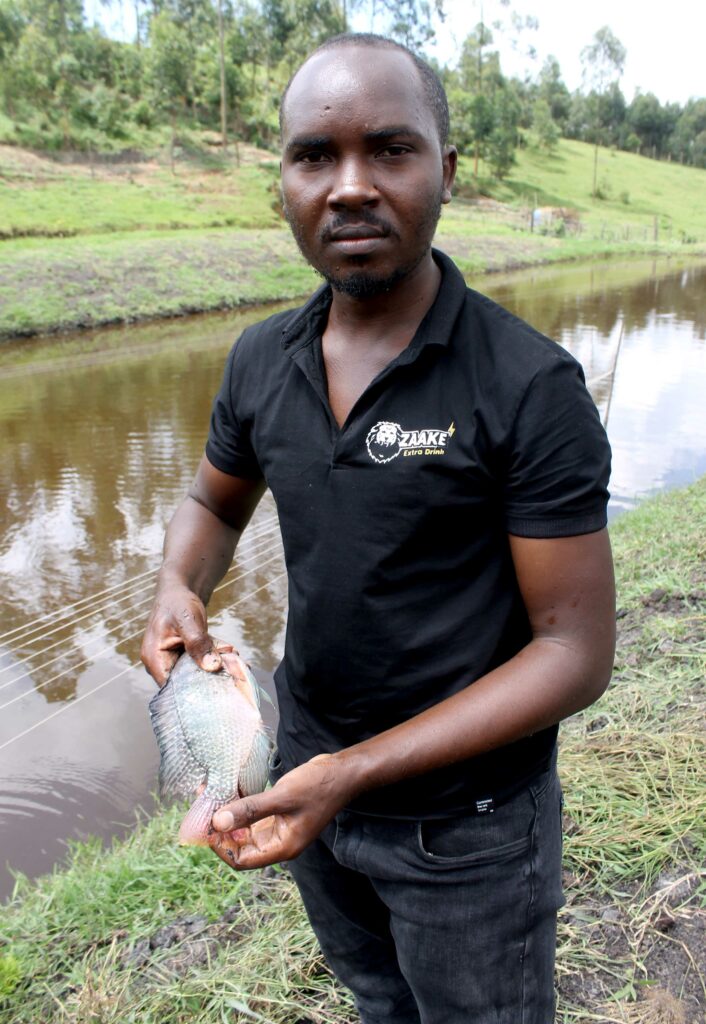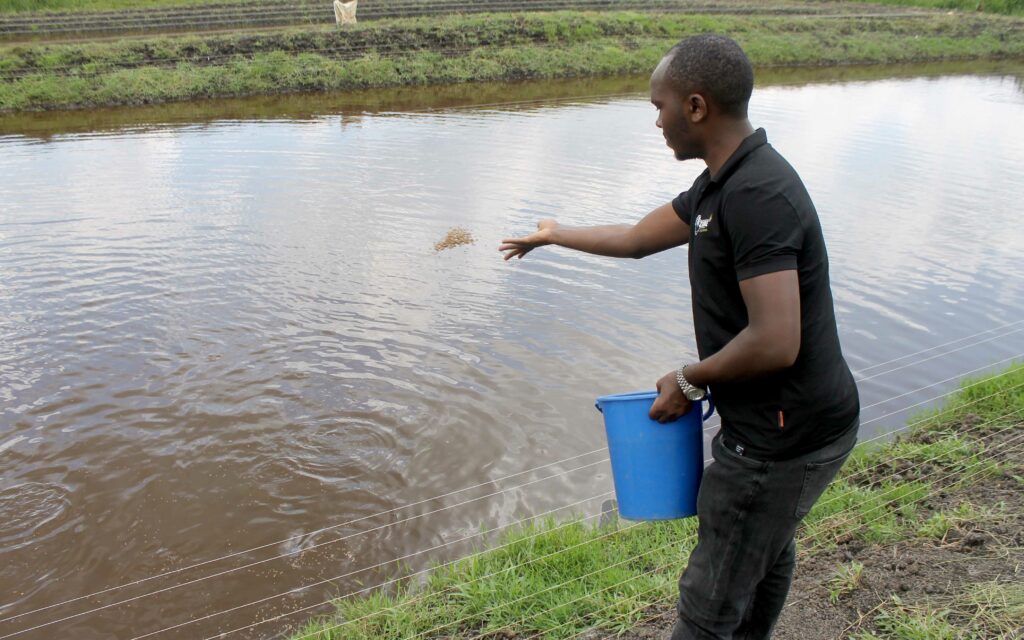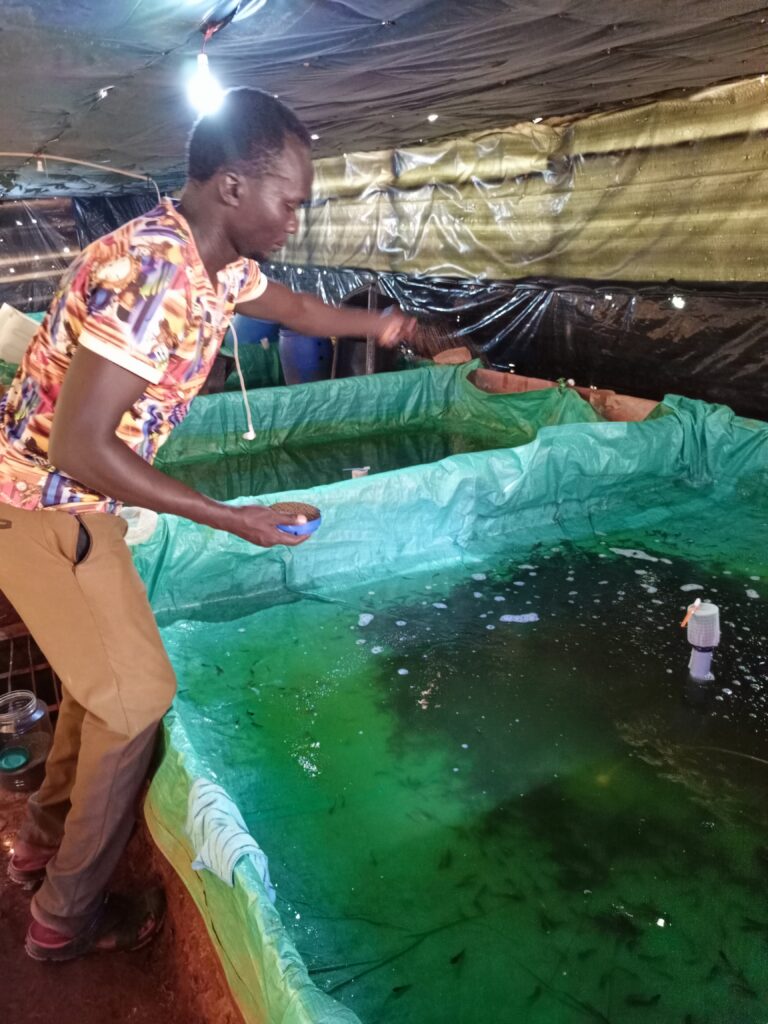By Ahumuza Muhumuza and Joshua Kato
Fish farming is a lucrative agribusiness as demand outstrips supply in Uganda.
“The country consumes 870,000 metric tonnes of fish, yet only produces 570,000 tonnes annually,” Charles Mulamata, the chairperson of African Aquaponics Association, says.
“That means there is a deficit of 300,000 tonnes that is imported from other countries, mostly China. If you multiply this figure by the farm gate price of fish in Uganda, that is more than $420m (sh1.5trillion) that would go directly into the pockets of Ugandan farmers if we are able to close that deficit,” Mulamata says.
There are an estimated 20,000 ponds throughout the country with an average surface area of 500 m² per pond. Production ranges from 1,500 kg per hectare per year for subsistence farmers to 15,000 kg per hectare per year for emerging commercial fish farmers.
“Realising this huge potential, almost a decade ago, the Government set a target for fish production in Uganda to reach 1.7 million metric tonnes by 2025, from 120,000 metric tonnes per annum. Of these 1.7 million tonnes, 700,000 tonnes is to come from fishing, while one million tonnes is to come from farms,” Mulamata, says.
He adds that in order to achieve the Government’s target, hatcheries and nurseries in the country need to ramp up their production to 2.5 billion fry annually. Catfish and tilapia are the most farmed fish in Uganda because they have ready market and they are the easiest to rear. Catfish, however, is hardier, more resilient and easier to farm than tilapia. Mulamata says entering the catfish nursery business is a lucrative venture for prospective farmers.
Just like any other business venture, however, starting and running a fish farm requires hard work, perseverance, and a passion for the business.
Mulamata says starting a fish nursery is an often-overlooked venture that can be adopted by the masses. He adds that the market for fish is huge, both local and export, if only farmers can master the numbers. Fish and fish products are usually among Uganda’s top five food exports – taking second or third place depending on the year.
Uganda’s fish is mainly exported to Europe, but Australia, Asia, the US and Egypt are other important markets that Uganda supplies. According to the Food and Agricultural Organization, Uganda is the second largest aquaculture producer in Sub-Saharan Africa after Nigeria.
Mulamata says with the right aquaculture practices, fish, especially catfish can be a gold mine in your backyard. Here are the things a prospective farmer needs to consider before delving into the catfish nursery business:

Research and Planning
Before diving into the fish farming business, it is crucial to conduct thorough research. “Sit down and draw a business plan,” Mulamata says. “Find out how much feeds cost, find out how much fish costs on the market. But do not just go with the price you see at the market near you, find out the farm gate price. You may find fish costs sh15,000 on the market, but those who buy from your pond pay you sh5,000 – that is the farm gate price. Do the calculations and see whether you will make a profit,” Mulamata says.
Develop a business plan that includes financial projections, marketing strategies and operational guidelines, says Sophie Apio, who runs a catfish nursery in Kigo, Wakiso district.
Samuel Kange, a large scale fish farmer in Namayingo, Eastern Uganda further advises that prospective farmers must do research on feeds and sources of feeds. “I know many farmers who have started fish farming but failed later because they could not feed them,” he says. He adds, and yet just like any other living thing, the better you feed them, the faster the returns,”
Pond selection
There are three major technologies of fish farming. The first is the traditional pond farming which is widely practiced in Uganda. Then there is cage farming mostly done on large bodies of water. The third method of fish farming is tank fish farming, which is rapidly gaining traction in the country.
Tank fish farming has the highest potential, according to Angela Nambalirwa, a fish farming expert who works with Commercial Fish Farmers Cooperative in Bira, Wakiso, says. It has the highest stocking capacity, is the most secure against predators, theft, and extreme elements of weather. Because it can be practiced in close proximity, in the backyard, it offers the farmer better management.
“If you have young fish that are supposed to feed every two hours, it is easier to do it in a tank in your backyard, than in cages miles away,” she says. It is also easier to monitor the fish’s health and wellbeing since the water in a tank is clearer than that in a pond or lake.
As far as stocking, in commercial farming, the more the numbers, the higher the income, Nambalirwa says.
“Let us take a reference of 1,000 litres: in the traditional pond system, you can stock a maximum of two kilogrammes of fish. In the cage system, you can stock a maximum of 30 kilogrammes of fish in 1,000 litres. While the tank can stock a maximum of 100 kilogrammes of fish in 1,000 litres,” she says.
Fish tanks can be designed and built in a vast array of ways. At Mulamata’s hatchery in Nakabugo, Wakiso district, there are 70,000 litre tanks made using plastic held in place by welded metals. Mulamata says setting up such a system costs about sh44m. He has come up with a cheaper option: the earth bag technology pond which holds the same amount of water, but costs between sh5m and sh10m to construct. It is built using sacks filled with earth to support tarpaulin that holds the water.

Open Ponds
According to Kange, after ascertaining that the site has got all the requirements of a good fish pond, then the excavation starts. There are two ways of digging a pond. Farmers with the means hire tractors to excavate the ponds.
“The average cost of using a tractor to construct a 20x40metre ponds sh10m. But this is a bigger pond. A farmer can construct smaller ponds of say 10x15metres depending on their desires at sh3m or even less using manual labour,” he says. Note that a tractor takes a shorter time to accomplish the job, compared to manual labor, however manual labor is cheaper and affordable for small holder farmers.
Kange advises that the pond must be rectangular, because this makes it easy to maintain, especially when guarding it against silting. It is also easy to harvest fish from a rectangular pond than from a pond of any other shape because you can easily sweep through all the corners. If several ponds are constructed, they should be parallel to each other to ease management.
“Make sure that each pond has got an inlet and outlet. It must have the right depth of about 4feet at the deep end and a gradient to easy harvesting,” Kange says.
Feeding and nutrition
Fish fingerlings can be got from several sources, including farmers or fisheries research institute at Jinja or Kajjansi. Average price is sh250 each. Feed constitutes 60 to 70% of the costs of running a fish farm, Denis Abili, an agricultural scientist says. He adds that a well-balanced diet is essential for the growth and development of young catfish. Abili says a nutritionally balanced feed should meet the specific requirements of your fish.
To ensure fast growth of your fish fry, the protein content, fat levels, and vitamins should all be adequate. Establish a feeding schedule and monitor the fish growth to adjust feeding practices accordingly. The fish should start off on a high protein feed and the ratio is gradually reduced as the fish mature, Abili advises.
Richard Ddungu, the aquaculture scientific fish breeder at the National Agricultural Research Organization (NAR0), advised farmers to use a cost-effective method called the Feed Conservation Ratio (FCR) which is a trick that can help them save themselves from making losses and costly prices for fish feeds.
“With FCR, you must ask the seller to explain how much of their feed is needed for one kilogram of fish. If they do not have the right facts, run for your life because you do not want to make losses,” he advised.
He noted that 70% of the farmer’s income goes to the fish feeds and that means noting that as a matter of fact, good quality feeds are quite expensive as the cost of making them is also high but farmers should do a cost-benefit analysis on feeds in the market before they can purchase them.
“People want to use cheap fish feeds, but poor quality and inadequate feeds lead to fish-farming stagnation, which cannot earn a farmer much money, therefore, I advise farmers to carefully consider high-quality fish feeds,” he noted.

Water quality Management
Water is extremely crucial to fish as it is where they do everything: breathing, feeding, reproducing, urinating and defecating. The leftover feed that remains in the water is high protein and generates a lot of nitrogenous waste which can kill the fish, Mulamata says. He emphasises that maintaining optimal water quality is crucial for the health and growth of your catfish. Regularly test water parameters such as temperature, pH levels, ammonia, and dissolved oxygen levels, he says. There are kits available on the market for testing each parameter.
“You have to make sure you are abiding by the parameters of what constitutes good animal husbandry. For example, if you have a tank of 2,000 litres and you measure and find the amount of dissolved oxygen is low, you can increase the amount of air stones from two to four or six, and then test again,” Mulamata says.
Airstones, also known as aquarium diffusers, are devices used in fish tanks to improve aeration and water circulation. When connected to an air pump, the airstones produce a stream of tiny air bubbles which rise to the water’s surface, creating agitation and increasing oxygen exchange.
“If the pH level is low, you can remedy the situation by adding calcium carbonate powder to raise it. Neutral pH is seven, below seven is acidic, above seven is alkalinity; fish prefer 7.2 to 8.5 pH,” Mulamata explains.
Ammonia accumulation is usually caused by a lot of waste in the water. “In case of ammonia accumulation, stop feeding the fish immediately until the situation is resolved. Remove the waste as fast as possible and add fresh water,” Mulamata says.
Implement effective water filtration and aeration systems to ensure a healthy environment for your fish. Regular water exchanges or treatment measures may be necessary to prevent the accumulation of harmful substances. “Do not wait for the water to smell first before changing it because by then it is very dangerous for the fish,” Nambalirwa says. African catfish, just like tilapia, is a warm water fish so water temperatures should not drop below 50 degrees Fahrenheit, but the fry need much higher temperatures to thrive.
Nambalirwa says there are several technologies for managing the water sustainably including aquaponics, recirculation systems, and the traditional changing of water. Creating a conducive environment for fish growth may also require essential equipment such as aeration systems, water filters, and feeding mechanisms.
Disease prevention and management
Catfish are susceptible to various diseases, which can severely impact a nursery farm’s productivity. A farmer should implement biosecurity measures to prevent the introduction and spread of pathogens. “Regularly monitor your fish for signs of illness, and consult with a veterinarian specialised in aquaculture if necessary,” advises Apio.
For ponds, according to Vincent Sebutemba, a fish farmer, thebiggest threat comes from predators especial reptiles like snakes and large lizards for example alligators, plus fishing birds. You can keep off the reptiles by planting repellant plants for example tobacco and lemon grass around the ponds.
“Dogs and cats can also reduce incidences of reptiles coming to your ponds to steal fish. You should also keep the pond area well cleared of over growing grasses. To keep off birds, set a wire gauze over the ponds so that birds cannot swoop low into the ponds,” he says.

Types of nurseries
Mulamata says producing quality fish starts with a hatchery at the apex, where the fish are kept until they reach one gramme. These are then moved to nursery one, that grows them out to three grammes. At three grammes, they are moved to nursery two where they are grown to 10 grammes in 30 days, at which stage they are ready to go into the grow out ponds.
At Mulamata’s hatchery in Nakabugo, Wakiso district, the fish are grown to one gramme in 15 days. The one gramme fish are then sold to nursery one which grows them to three grammes in 30 days.
Mulamata says starting a hatchery and nursery one is a complex endeavour requiring a high level of technical knowledge and capital to set up and run. He, however, says there is a huge potential for farmers to enter the industry in nursery two. In nursery two, farmers grow the fish from three grammes to 10 grammes which is the suitable size for selling to grow out ponds.
“If one has a 7,000-litre tank, you can stock 70,000 fingerlings. If you buy the 70,000 fry at sh100 each and sell them at sh400 a month later, you will earn a gross income of sh28,000,000,” Mulamata says, “That is why I call it the gold in your backyard.”





